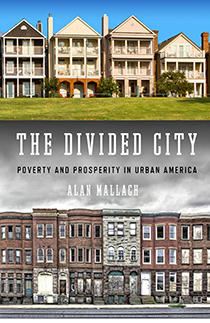
The astounding revival of American cities is real. However, the inequality evident in virtually all of them is real as well, and built into the system. Much of the urban discourse has centered on the former, but the latter has likely has a broader impact on contemporary metropolitan development nationwide. Inequality in American cities has three dimensions – spatial, economic and racial. The erosion of the middle class is a key feature of industrial city decline and most impacts older industrial cities. And of course, sweeping global and national trends are at work.
That's the thesis of The Divided City: Poverty and Prosperity in Urban America by Alan Mallach. Mallach is a senior fellow at the Center for Community Progress in Washington DC. A city planner, advocate and writer, he is nationally known for his work on housing, economic development, and urban revitalization, and has worked with local governments and community organizations across the country to develop creative policies and strategies to rebuild their cities and neighborhoods. A former director of housing & economic development in Trenton, New Jersey, he currently teaches in the graduate city planning program at Pratt Institute in New York City. His book was released in June 2018, but this review was prompted by two interactions I had with him over the last several months -- I interviewed him at a student event at the University of Chicago's Harris School of Public Policy in April, and we shared a panel at the Cleveland Fed's Policy Summit 2019 held in Cincinnati this past June.
Mallach starts by describing the rise and fall of the American industrial city over the 19th and 20th centuries. He raises the point that American cities developed as centers of commerce first, and livable spaces second -- creating the foundation for today's inequality. He also noted that while some cities went all in on the singular economic generator that was driving growth at the time, others added pieces -- principally the growth of universities and medical institutions -- that would be instrumental in their future development.
Universities and medical institutions, or eds and meds, became the link between industrial cities and the rise of the tech-driven economy beginning in the 1980s. This created a fundamental shift in the relationship between a city’s economy and its amenities. In the industrial era, it used to be production > wealth > amenities; today consumption, production, wealth and amenities all feed each other, and create greater inequality in the process.
Mallach then covers ground that's gaining traction and acceptance in academic and popular literature (white-black segregation is an explicit outcome of intentional public policy, implemented over decades), and topics of unending popularity (what does gentrification even mean anymore?). But using Indianapolis as an example, a city often mentioned as a Rust Belt recovery success story, he finds that neighborhood decline is the rule in cities, not the exception. He also details how small cities, former mill towns, and struggling inner-ring suburbs of major cities, or manufacturing-dependent places that never developed the eds and meds link that would connect them to the modern economy, have been hit hardest.
For those who say the federal and state governments should incentivize moves from areas lacking economic opportunity to those with abundant choices, encouraging and hastening the eventual collapse and regeneration of failing cities, Mallach suggests it won't work. He notes that many former industrial cities function on the bare-bones low-paying jobs and transfer payments (welfare and food stamps, Medicare and Medicaid, disability and Social Security) that provide just enough money for the cheap housing they have and the dollar stores that serve them. Call them cities on life support.
Solutions involve overcoming significant political hurdles, when most of the urban discussion remains around how to temper successful urban areas, and not on addressing the challenges of continued decline. But Mallach suggests the following:
• An integrated workforce system is the necessary first step for inclusive revitalization. Jobs, jobs training, skills training, adult education, continuing education, counseling and family support are crucial.
• Education and opportunity, such as the provision of low- or no-cost pre-kindergarten programs, are next.
• Recognizing the correlation between place and opportunity through the expansion of programs like the housing voucher program can improve circumstances too.
• Look to establish space equity through ensuring that affordable housing remains in the most in-demand areas.
• Utilize “collective efficacy” – the ability of a community to establish norms and enforce them through social control – to improve the quality of life in troubled neighborhoods.
• Harness the resources of eds and meds in smaller industrial cities.
Consider regional CDCs in areas without the population scale to create one on its own.• For the small cities, mill towns and struggling suburbs that don’t have the ability to utilize these tools, bolstering their public-sector economy, perhaps something like the urban transfer-payment model, may be the last resort.
And cities must always seek ways to sustain whatever gains are made.
All are worthy solutions. But my sense is that few will be employed until there's a downturn in the economy that impacts recently revitalized city neighborhoods as well as distressed ones, and they'll drive the revitalization policy debate.
This piece originally appeared on The Corner Side Yard.
Pete Saunders is a writer and researcher whose work focuses on urbanism and public policy. Pete has been the editor/publisher of the Corner Side Yard, an urbanist blog, since 2012. Pete is also an urban affairs contributor to Forbes Magazine’s online platform. Pete’s writings have been published widely in traditional and internet media outlets, including the feature article in the December 2018 issue of Planning Magazine. Pete has more than twenty years’ experience in planning, economic development, and community development, with stops in the public, private and non-profit sectors. He lives in Chicago.












